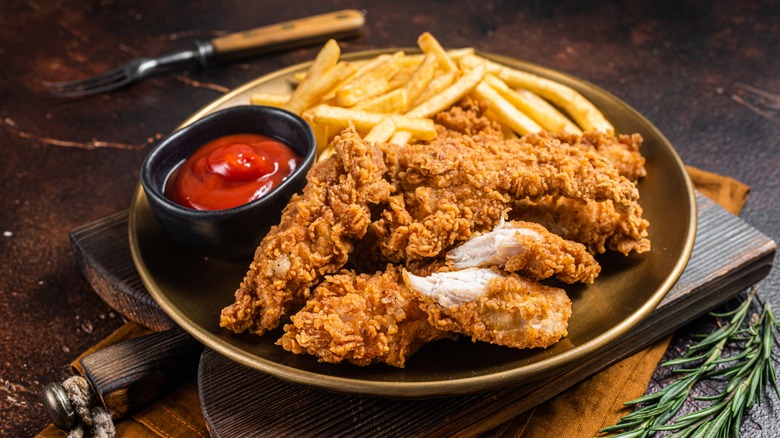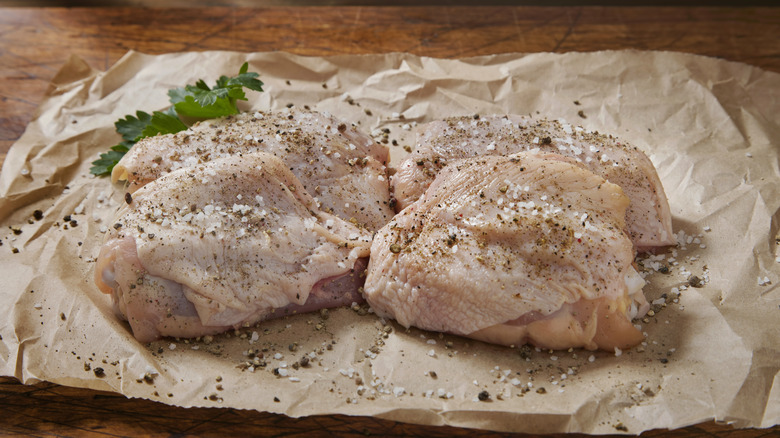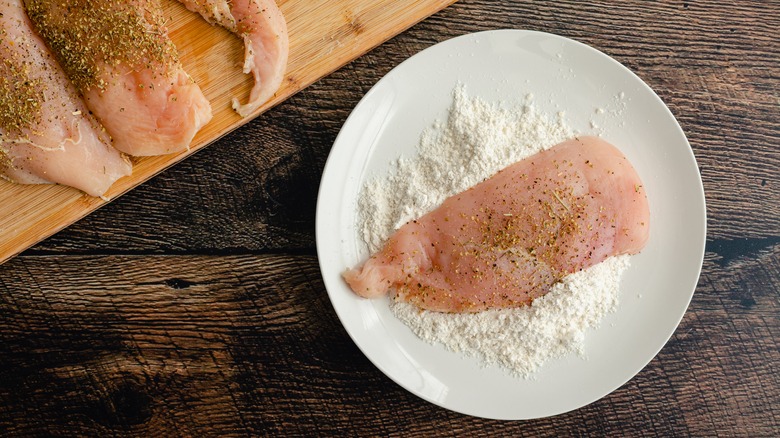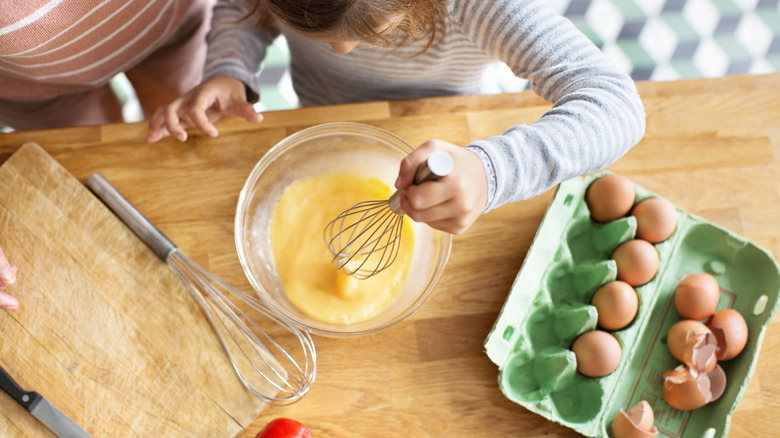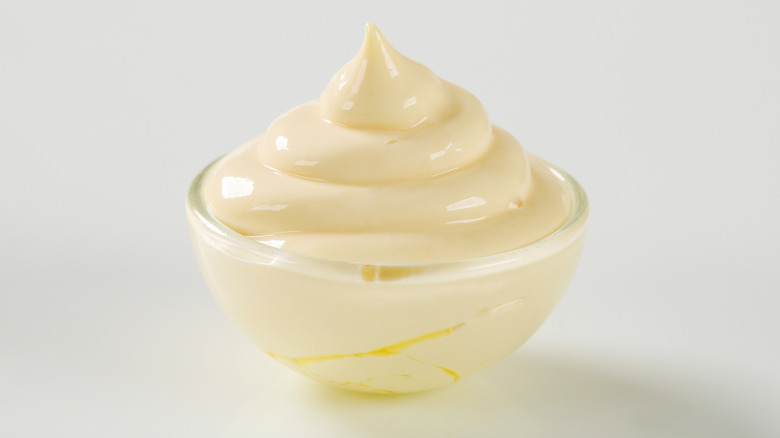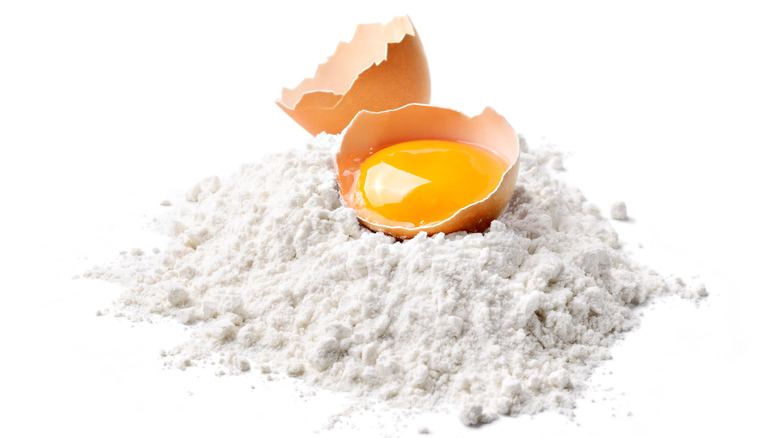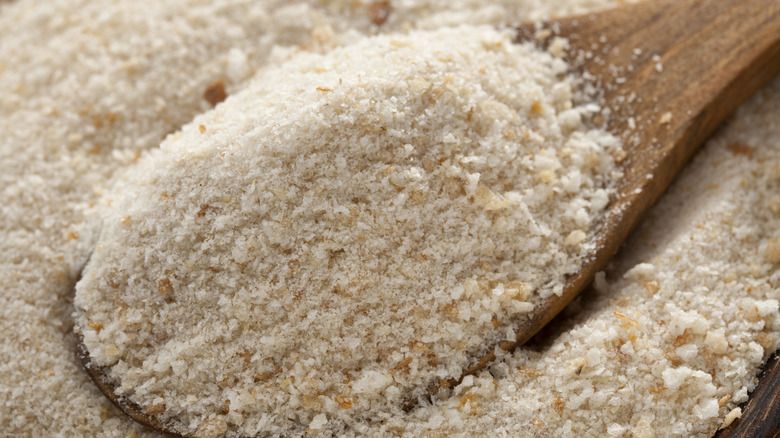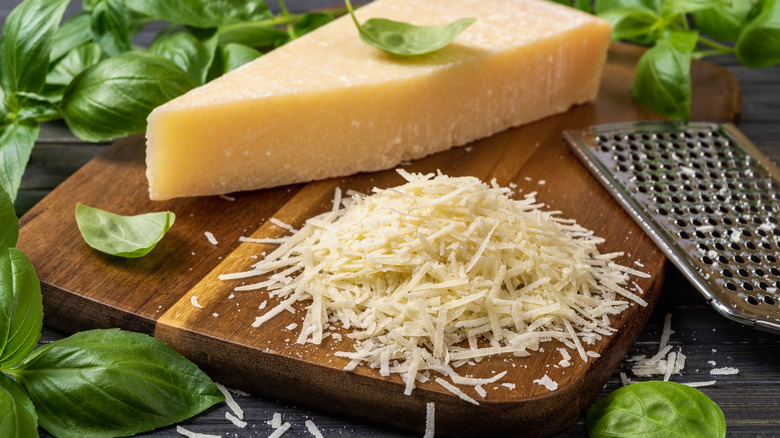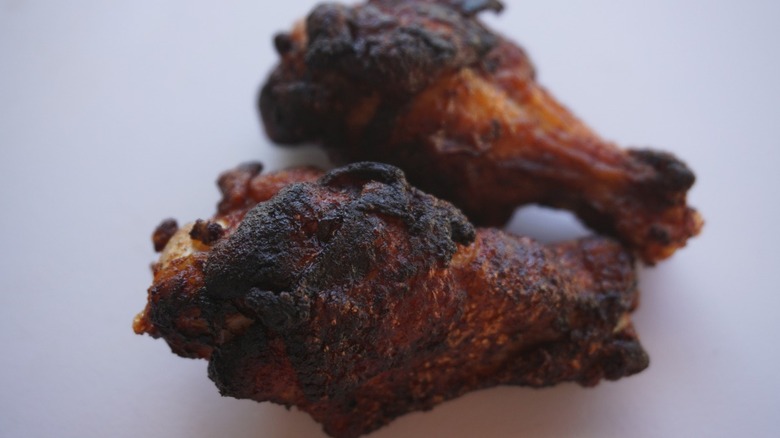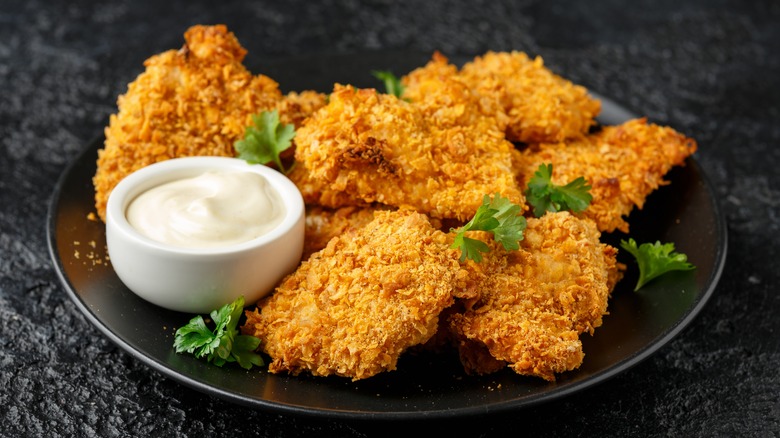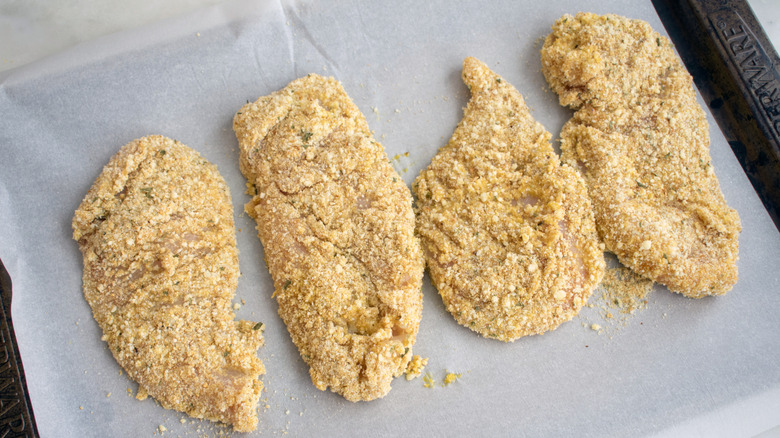10 Mistakes Everyone Makes When Breading Chicken
Have you ever tried to make breaded chicken and it came out all wrong? Maybe the breading was hard or maybe it tasted eggy, or maybe all that precious breading just slid right off when you picked it up! A good breading is a must-have for fried or baked chicken, but breading that chicken isn't as easy as it may seem. Don't worry, though, I've got your back.
I have been breading chicken for much of my life and, as with most things, it took a while to get it right. I have learned that the order you add your flour, egg, and breadcrumbs matter, and I have learned that a little bit of spices can make a big difference. I have also learned many smaller, less obvious tricks through trial and error and from watching other chefs. So now, I am compiling a list of common chicken-breading mistakes so that you can avoid them and get the perfect breaded chicken every time.
1. Mistake: Forgetting to add salt directly to the meat
This is, admittedly, one of the biggest mistakes many people make. If you only add salt and pepper to the flour and/or breadcrumb mixture you are breading the chicken with, your meat itself might come out of the oven or frying oil with minimal flavor. The crust will have all that delicious flavor, but the interior of the chicken will be bland because the salt didn't get close enough to really seep into it.
While you should add a pinch of salt and pepper to your breading mixture, you should never forget to do the same to the chicken itself prior to adding that breading. This way, the salt is able to melt into the meat, flavoring it as well as the breading. Just be sure not to go overboard; if you put a lot of salt on the chicken, be careful not to add too much to the breading, since you will be eating them together.
2. Mistake: Dredging in the wrong order
Raise your hand if you usually start breading your chicken by dipping it into beaten egg. You're not alone! It seems obvious that you should add the protein/wet/sticky layer first so that the other, dryer things you are adding to the chicken will stick. But, in this case, the most obvious line of thinking is not the correct one. If you start with the egg, the chicken will turn out drier and the breading may not stick as well. This is an extremely common mistake, and switching things around just slightly will give you better results.
First, you should always pat your chicken dry. Then, after salting and peppering your chicken, dip it directly into some all-purpose flour. Leave a thin coat of flour on the chicken, shaking off the excess. Then and only then should you move on to the egg dip. The addition of the flour before the protein layer keeps the chicken moist and tender, and allows the crust to get crispier. After that, you should add the breadcrumb layer, which will stick to the egg wash. This method is also very effective when breading other meats like pork chops and steaks, so it is definitely a trick worth keeping in your cooking arsenal.
3. Mistake: Not beating the eggs enough
Okay, we're not talking about beating your eggs with a mixer here; there is no need to go that far. However, it's still important to beat them very well with a fork or a whisk in order to thoroughly mix the yolk with the white. If you don't, then your egg wash will be inconsistent and blotchy, which doesn't only look strange before cooking, but may also cause the chicken to cook unevenly. So, energetically beat those eggs in a shallow bowl to get a homogeneous, light yellow mixture before dipping the chicken in it.
As an added tip, be sure to let the excess egg wash drip off before moving on to the breadcrumbs as well. Otherwise, you may end up with chicken that has thick patches of egg in some places, or just some very eggy-tasting chicken. While adding chicken might be an interesting way to liven up a plate of scrambled eggs, doing the opposite makes for a strange batch of fried or baked chicken.
4. Mistake: Thinking only eggs can hold the breadcrumbs
The biggest challenge when making breaded chicken is getting that breading to stick. To do this, you need to bring in a protein, like an egg wash. But, don't feel penned-in by this recipe; you can use many other things to make the breadcrumbs stick as well.
One of the most popular egg alternatives when making fried chicken is buttermilk. Not only will it make things stick together, but it also adds a little tang to the mix. If you want more tang than that, you can use mustard (we would recommend Dijon for this). Mayonnaise is a popular option when it comes to baked chicken, especially in recipes like the simple-but-delicious Parmesan-crusted chicken.
If you want to keep things lighter, you can use olive oil in place of a protein. This works great for pan-fried chicken, and opens the dish up to the addition of other, spicier flavors like red pepper flakes. It is also neutral enough not to overshadow ingredients like Parmesan cheese, parsley, or other herbs in the breading.
5. Mistake: Not making 'glue' to hold the breadcrumbs on
Have you ever thought about making breaded chicken, only to have your mind go straight to the giant mess you will inevitably make in the kitchen if you do? Cooking is messy, and that's fine, but breaded chicken is particularly chaotic, as it usually involves the use of at least three bowls for the dredging and breading. You need a bowl for the flour, a bowl for the egg wash, a bowl for the breadcrumbs — not to mention the plates for the raw chicken and the breaded chicken!
This tip will help you cut down on the plates and bowls by at least one. Instead of having a separate bowl for the flour and the eggs, mix them together into a "glue" instead. This saves you a step, as well as some time. It can also save you a lot of flour, as you will be wasting much less of it in this scenario. To make this glue, add 1 tablespoon of flour for every large egg in your mix. This will create a thicker paste that will help the breadcrumbs stick to, not just chicken, but anything else you would like to bread.
6. Mistake: Not seasoning your breading
Breaded chicken seasoned with just salt and pepper is good, but if you want to make it great, you should add a little something extra in the way of herbs, spices, and perhaps even cheese. If you like your breaded chicken hot, try sprinkling some cayenne pepper or paprika into the breadcrumb or flour mixture. For a more Mediterranean feel, add some Italian seasoning or herbs like parsley, basil, or oregano. You can also add garlic or onion powder, lemon pepper, or thyme. Open that spice cabinet and experiment! For a cheesier choice, Parmesan cheese is a great addition to the breadcrumb mixture.
When you add herbs and spices to your breading, you should always keep your recipe in mind. If you are frying your chicken in hot oil or baking it on a high rack in the oven, it is probably best not to use too much fresh parsley or other leafy herbs, as they tend to burn. If you are baking chicken in the middle of the oven as usual, these herbs should most likely be fine, especially if you cover the chicken for part of the baking time.
7. Mistake: Adding too much cheese to the breading
Do you remember how we said that you can add Parmesan cheese to your breading mix? Well, there is a bit of a caveat to that. Yes, Parmesan is a delicious addition to chicken breading, but this is only true if you add it in the right amount. If you are too heavy-handed with that plastic shaker jar, you could end up making the crust soggy or burnt, depending on how you are cooking your chicken.
If you are baking the chicken, for instance, those little flecks of Parmesan will start to melt and come together as the chicken cooks. They will form a goopy (and later hard) layer around your chicken that will make it into something entirely different from the nice, crisp breaded meat that you were striving for. To avoid this, simply rein it in a bit with the cheese. As long as you don't add (too much) more than the recipe calls for, everything should be fine.
8. Mistake: Laying it all on too thick
If you have ever made fried chicken that could break a tooth, this common mistake is likely the culprit. Making any of the layers involved in the breading too thick can cause things to come out wonky. In addition to holding your chicken over the bowl to let the excess egg wash drip off, you should also dust off any excess flour or breadcrumbs too.
You may think that the thicker the breading, the crunchier the crust, but this is not usually true. If you have more breading than needed, either all over the piece of chicken or in spots and chunks, you will end up with chicken that doesn't cook evenly. Often, it will end up raw on the inside but hard as a rock on the outside, and that's just not what anyone wants. Although it may take a few extra seconds, it is definitely worth giving the meat a shake or a pat before moving on to the next stage if you want to achieve the perfect breaded chicken.
9. Mistake: Not experimenting with other coatings
Bored of your regular flour-egg-breadcrumb routine? Take your breaded chicken to a new level by using a different coating. Crushed crackers, like Ritz, make a great crispy coating as well, and so do crushed pretzelsand crushed cornflakes – just remember to use the variety, not Kellogg's Frosted Flakes.
There are several ways to crush these ingredients up, but perhaps the easiest involves a rolling pin. Place the crackers, corn flakes, or pretzels in a zip-top bag and roll over them with the rolling pin, crushing them thoroughly. Your goal is to make the pieces very small (resembling breadcrumbs), so that they stick to the chicken, although the corn flakes are one coating that can be left in slightly larger chunks.
If none of that sounds good to you, there is one other option. You can also omit the breadcrumb layer all together and just coat your chicken with flour for a simpler, faster breading that works well with vegetables and sauces.
10. Mistake: Not resting your chicken after breading
If you have done all the other things on this list and the breading is still falling off your chicken when you try to fry it or when you pick it up to serve it, then there is one more problem it could be. Perhaps your chicken is not getting enough rest.
After you have breaded your chicken, it is a good idea to let it rest, untouched, for around 10 minutes before you fry it (you should let all meat rest after cooking too, FYI). This gives the breading more time to adhere to the chicken, which, in turn, means that it won't be falling off when you cook it. If you want to rest it longer than that, however, it is a good idea to put the chicken in the refrigerator so that it doesn't get too warm. After it has had enough time to set, proceed with your frying or baking as usual, and you will likely see that finally, at long last, your breading stays on.
